Boards for Kitchen Flooring? Learn Why You Should Consider It!
Hardwood planks are a popular option for house flooring. They are typically used in rooms like a living room or bedroom. Recently, however, hardwood flooring has appeared in kitchens as well. Is it a good solution? Learn its advantages. Check which type of boards is best for kitchen flooring and create a unique character in the interior.
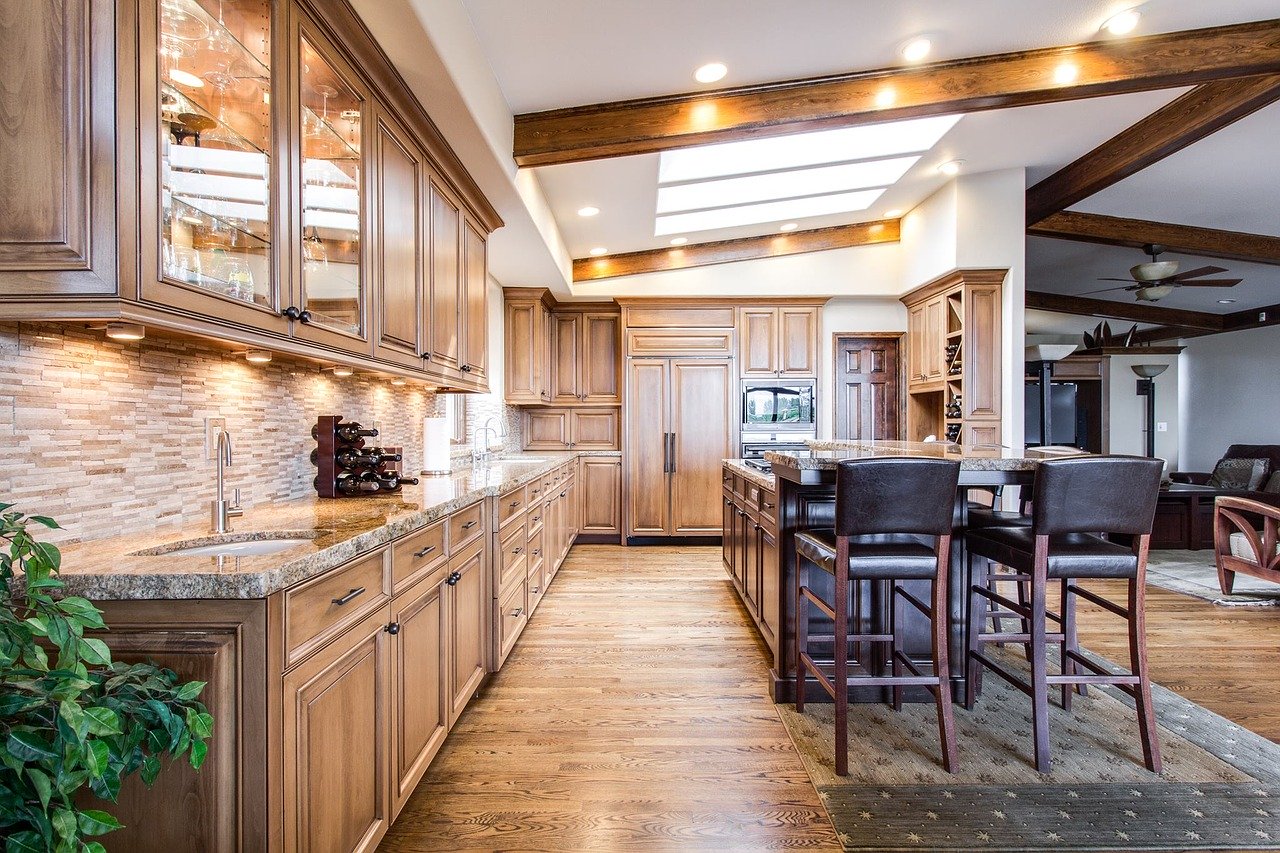
Wood kitchen flooring - products available on the market
Are you wondering which kitchen flooring is suitable for you? You cannot decide between particular flooring boards? There are several possibilities and each of them has its own advantages and disadvantages. The most common options are:
- hardwood flooring,
- laminate flooring.
Hardwood flooring - whether it’s engineered or solid wood, is exceptionally resistant to damage. The boards are covered with a special layer during their production. They do not require any additional treatment or preservation. Because of the high durability of wood the flooring boards used in the kitchen are resistant to moisture and high temperatures.
Hardwood flooring is not entirely flawless. The joints might be problematic - they are far less resistant to moisture than the surface. If some moisture remains on a joint for a longer time, the edges of the boards might get deformed.
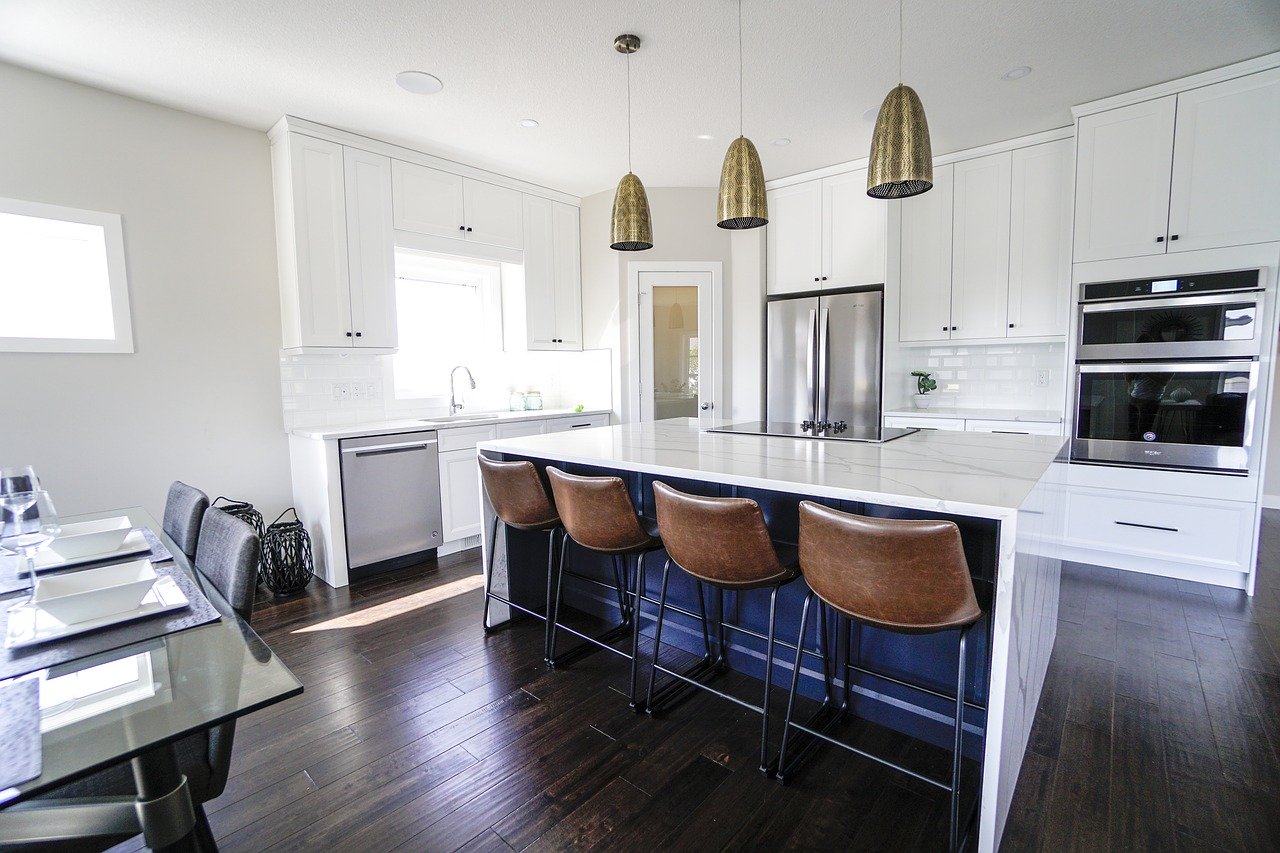
Another popular option for kitchen flooring is laminate flooring. The boards are resistant to damage and sunlight, so you don’t have to be concerned about discolouration. Laminate plank flooring might also be suitable for floor heating, and it’s a commonly chosen option. Because of high temperatures remaining by the floor surface, the planks are installed without glue.
Laminate flooring installed without glue can be reused in another room. No additional expenses are required.
Kitchen flooring boards with a special antibacterial layer are the latest trend in laminate flooring.
Does laminate plank flooring have any drawbacks? Unfortunately, weak soundproofing might be a problem here. If you decide to buy this type of kitchen flooring, consider adding a good quality underlayment which will solve this issue. Laminate flooring is more prone to abrasion in the kitchen - but that depends on the quality and price.
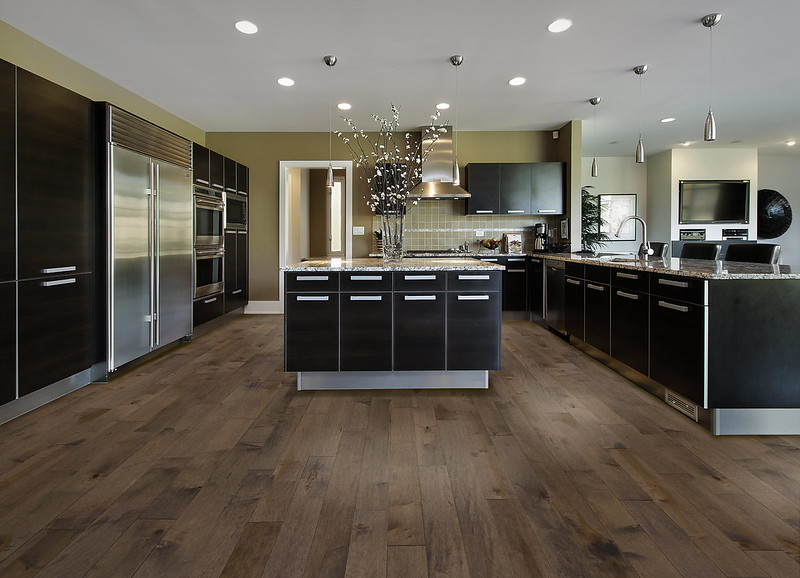
Waterproof hardwood flooring for the kitchen
When choosing the right kitchen flooring, you should pay attention to an important issue - water resistance. Many customers might get confused here and buy not what they expected. There are waterproof flooring boards on the market, however this doesn’t necessarily mean they are watertight. What’s the difference? It depends whether the ‘waterproof’ term refers to the surface or to the joints of wood flooring boards. Kitchen flooring is exposed to moisture, therefore make sure to choose laminate or hardwood flooring with watertight joints.
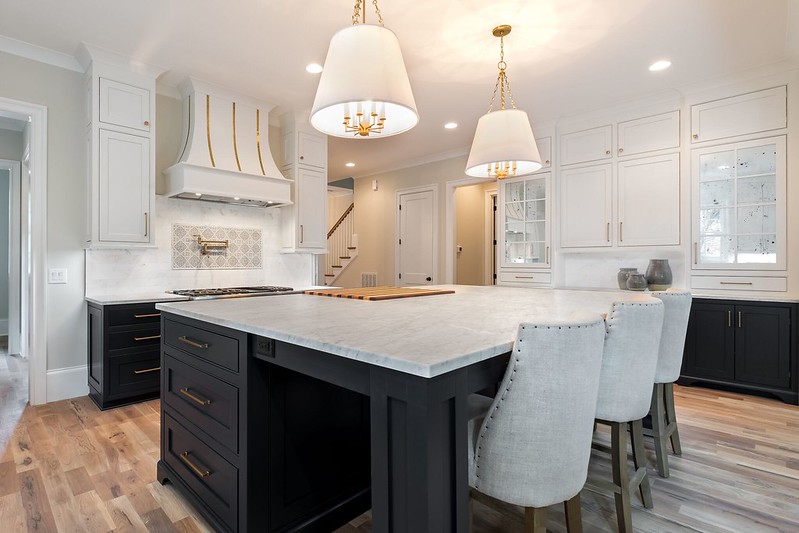
Laminate flooring for kitchen - abrasion class rating and durability
If you decided on laminate flooring for your kitchen, or any other room in the house, pay attention to the durability of the product. It is determined by durability class rating. It’s particularly important if the traffic is high in the area, however it is as significant for home interiors. There are six durability classes typically marked with numbers:
- 21,
- 22,
- 23,
- 31,
- 32,
- 33
For domestic usage, laminate flooring marked with the first number 2 is more than enough. Boards with number 3 are typically used in public areas. What is the best option for kitchen flooring? Choose a durable model with a high durability class - 23.
The durability rating evaluation process is quite interesting. The flooring boards are tested for their resistance to various factors. Other issues, such as resilience against abrasion, mechanical damage, staining, damage from cigarettes, moving furniture - e.g. chairs. Swelling increase rate is also tested.
Another important issue is abrasion class rating. In this regard, five classes have been distinguished:
- AC1,
- AC2,
- AC3,
- AC4,
- AC5.
The mentioned classes for boards durability concern standard laminate flooring. When it comes to more expensive hardwood flooring, as well as engineered wood flooring, one should pay attention to the wood hardness scale, with regards to particular type of wood.
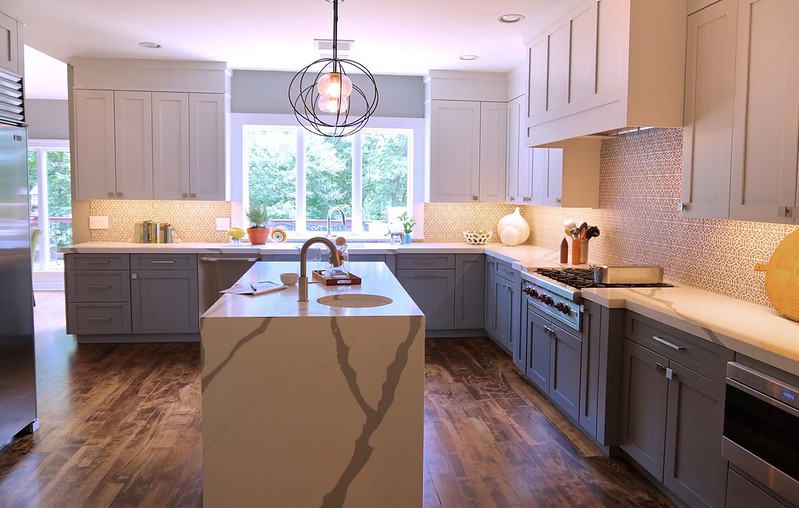
Kitchen flooring - tiles or planks?
The kitchen is a type of the room where the floor might get damaged by many different factors. Therefore many homeowners wonder which type of material is better to choose. The most common choice is tiles or waterproof flooring boards. Which solution is better? Much depends on the way you use the room. If you spend a lot of time in the kitchen, you cook a lot and in general use the kitchen a lot - tiles are the better option. Manufacturers offer a special type of tiles which closely resemble wood, so you do not have to give up the visual effect.
If you cannot choose between the two materials, you might compromise - lay tiles in the working area of the kitchen and waterproof hardwood or laminate flooring in the other part.
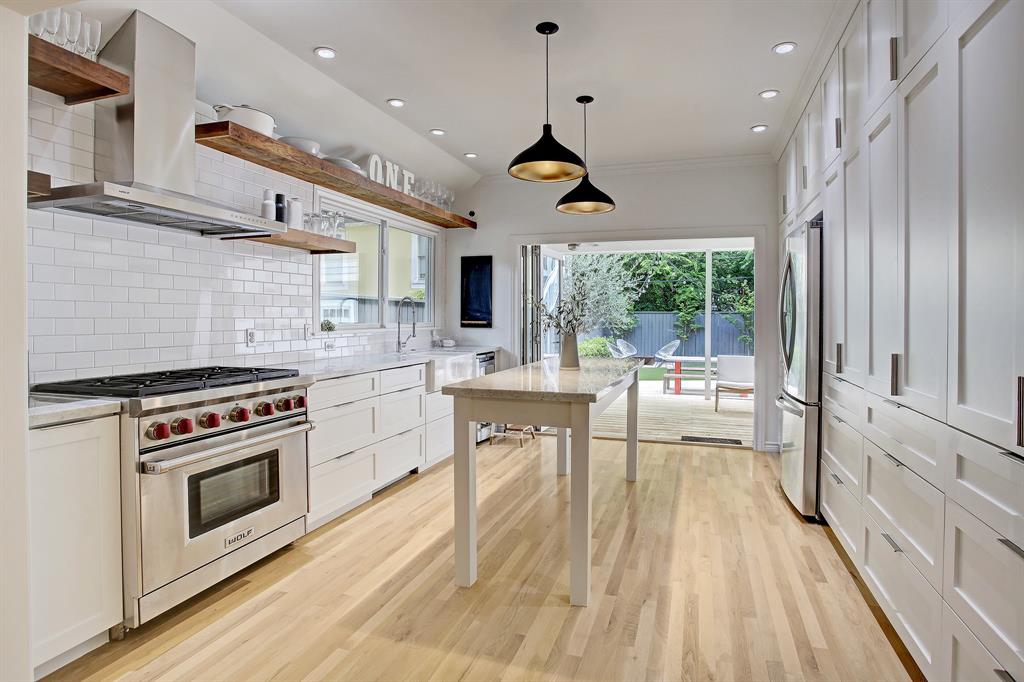
How to install laminate flooring or hardwood planks in the kitchen?
Board flooring installation is relatively easy, therefore, you should be able to do it yourself. Sometimes, however, insufficient knowledge might be the reason for common mistakes which will influence the durability of kitchen flooring. What should you keep in mind when installing floor in the kitchen?
The most typical mistake is not reading the instruction. Each type of boards - solid hardwood planks, engineered wood or laminate flooring - is different and often requires different actions. Spend a few minutes on reading the manufacturer’s instructions before you start working.

Another important issue involves the surface preparation. Kitchen flooring usually requires using special soundproofing underlayment. Furthermore, if you have underfloor heating, check whether the boards you are about to purchase are suitable for this.
If you install a “click and fit” type of flooring boards, make sure to connect each element precisely. If you neglect this aspect, it will result in unaesthetic gaps between the boards, which also affect the durability of the kitchen flooring.
How to clean kitchen flooring boards?
Hardwood or laminate flooring in the kitchen should be cleaned with a damp mop or a piece of cloth. Do not use an excessive amount of water on the floor, as it might affect its durability. You can use an appropriate cleaning product or water with small amount of dish soap.
Keep in mind that kitchen flooring boards should not be cleaned with strong chemicals. It might harm their durability and appearance. Cleaning product not meant for flooring boards might leave marks and discolouration on the surface.

Choose your ideal kitchen flooring boards - available models
Laminate flooring and hardwood planks one can use in the kitchen are available in many forms. For this reason, you have a lot of possibilities for design. Everyone can fit the product to their own needs.
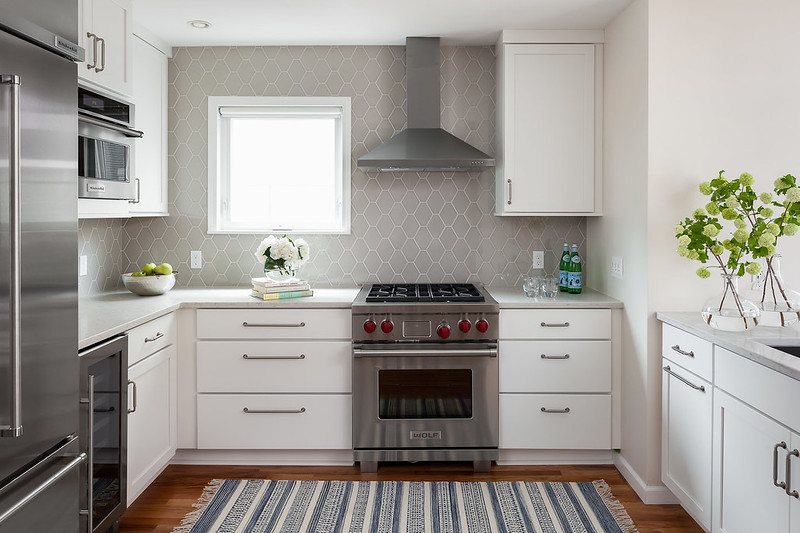
What kind of boards is the best for kitchen flooring? Laminate flooring which imitates natural wood are quite a popular option. Many apartments and houses are designed in the Scandinavian style nowadays, therefore flooring boards in this style are commonly chosen as well. Bright colours mixed with grey are particularly beneficial for bright or white kitchens.
Laminate flooring for the kitchen is available in any pattern you choose. If you have something unusual in mind, you have to place a custom order - typically more expensive. But in this case, there is no limitation. You can choose laminate plank flooring resembling concrete, sheet metal, stone or a colourful graphic from a favourite movie. It’s a perfect solution for someone who likes original ideas.
Are you wondering what kitchen flooring is the best? Analyse all benefits and drawbacks of laminate flooring, hardwood planks and engineered wood. Choose products of the highest quality which will result in a beautiful kitchen flooring lasting for years. You can also check how to use other unusual materials. Learn how to use stone tile in the kitchen.
Featured articles




